Proximity to the North Sea coast
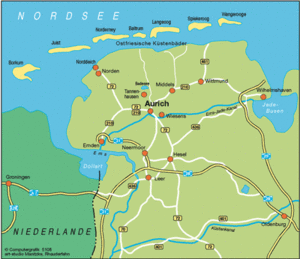
It is not at all far to the North Sea coast and the East Friesian islands set in the National Park of Coastal Mud-Flats (Nationalpark Wattenmeer), an area well worth visiting.
A quick look at the history of Aurich and this area:
Set at the centre of the East Friesian peninsula ( 7° 30 longitude and 53°30 latitude) Aurich`s origins date back to the founding of a church dedicated to St. Lambert. People are still not agreed today on the exact date of the founding of the town or where the name Aurich comes from, which could either be from a person (Affo) and his wealth (Reich) or possibly refer to the (Aue-reich), a fertile, well-irrigated area and (Aa), meaning waterworks. We tend to agree with the second theory and use this idea when advertising our small, homely town, which still today can easily be reached by water.
The founding of the church also marks the oldest part of town, around which a market settlement developed under the protection of the Tom Brook dynasty. For this purpose a castle was built just outside the settlement, on the site of the present-day Hotel Piqueurhof. A successor of Tom Brook, Fokko Ukena, secured the town with ramparts and ditches and built bulwarks against possible attackers. Unfortunately for him this did not help much, as nothing could hold out long during the squabbles of the chieftains, and the castle was completely destroyed in the middle of the 15th century. The Cirksena family was aquiring more and more influence and now took control of Aurich, building a new, more impressive castle on the site where the castle stands today.
The fighting and plundering of the Saxonian Feuds (1514) destroyed the original settlement around the church in Aurich, making it possible to rebuild the town on a more organized basis and covering a wider area. Thus the present market place was created for the cattle markets, which were already an important feature. The market moved from the site of the castle and with it the town centre moved further westwards, too.
Because of its central position, its fortified ramparts and the protection afforded by impassable moorlands, Aurich became the royal seat of the House of Cirksena, which died out in 1744. Aurich and East Friesia then fell to Prussia, became Dutch in 1806/07, French in 1811, Prussian again in 1813 until the Congress of Vienna in 1815, when the Kingdom of Hannover took power. Then in 1866 Prussia took over again.
Following the administrative reforms of 1972, which lead to the foundation of the Regional District Weser-Ems, Aurich lost its position as seat of government and capital of East Friesia. East Friesia lost its political boundaries and with them its significance as a regionally independent area of administration. But Aurich retained some government offices, and of course its central position and accessibility from all directions, which is why people still refer to Aurich today as the "secret capital" of East Friesia.
Activities and sightseeing
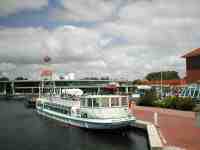
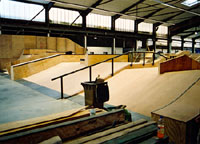
Boat Hire
People who like being on the water can really enjoy themselves here. You can hire boats with outboard motors for 3 or 5 people, and you don`t need a licence. You can do a day-trip to Emden and back, or spend two hours sailing out to the pub Kukelorum and back, including time for a drink, of course!
Naturally there are also paddle boats, rowing boats and canoes if you prefer those.
Pleasure trips on the Ems-Jade Canal between Aurich and Emden.
Boat rental (incl. paddle boats, rowing and motorboats) at Aurich`s port, next to the mooring place of the pleasure cruiser "MS Stadt Aurich".
Skate Hall Aurich
The Playground Skate Hall in Aurich is the biggest skatepark in Germany (3200m²) and a must for skateboarders, BMX and inliners.
Opening times: Mon.-Thur. 14.00 - 20.00hrs
Fri.-Sat. 14.00 - 22.00hrs
Sun. 10.00 - 20.00hrs
Tel. 04941/60 77 70
"Ewiges Meer"
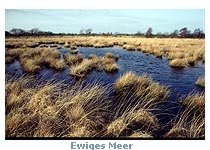
It is also not far from Aurich to the Germany`s largest moorland lake, the Ewiges Meer.
In the past it was an adventure to get to the Ewiges Meer, but it was always worth it, and it was not just nature lovers and walkers who came here. The shallow water of the lake warms up quickly in the summer and a strip of land about 400 metres long on the northern shore of the lake was once a popular bathing spot, because there was very little mud.
And while the water warms up quickly in the summer, it freezes over just as quickly in the winter, so all and sundry were here again - ice-skating.
That has all changed now, and the Ewiges Meer offers a different kind of experience.
That is not entirely true - you still come across skaters on cold winter days. Most of them, but unfortunately not all, take the boarded path directly to the water and step onto the ice without crossing moorland.
There are differing opinions about this, but a nature reserve really should be respected by everyone.
The boarded path for visitors which was constructed at the beginning of the 1980s on the north side of the lake (the south side is closed for visitors) has become a real attraction.
You can reach the path comfortably from the carpark in a few minutes and should plan at least 90 minutes for the actual round walk as there is plenty to see. The nature-trail was opened in summer 2000 and gives information about the Ewiges Meer. The question and answer games and hands-on exhibits are especially attractive for children. A friendly moor-lizard accompanies the visitor from one point to the next along the trail.
On good days up to 1000 visitors come here and even at other times you are rarely completely alone here. But if you want to be alone you should visit the lake in the early morning hours or in the autumn and winter. Then you can take in and enjoy the mystical and moving atmosphere all the more. You should visit the Ewiges Meer regularly to experience the different seasons. Each time you will be impressed by the different colours and romantic changes of scenery.
But be careful on the path in the cold and damp season - it could be very slippery: go carefully! Nature lovers might be interested in the guided walks offered by Horst Reichwein, a nature guide, from May to November. He covers aspects touching the moorlands, local history, culture and conservation.
If you are alone, you should never leave the boarded path, on the one hand out of respect for nature, on the other hand because from March on the adders wake up out of hibernation.
The moor-landscape at the Ewiges Meer is only apparently monotonous. Each person experiences it differently, but everyone can discover something new here and is bound to succumb to its austere beauty.
At the Ewiges Meer we meet a world which is full of contrasts, but also highly sensitive, in which the past and present mix together in a fascinating way.
A quotation from a report on the area: "You`re not allowed to do anything here - that`s what`s so special about it."
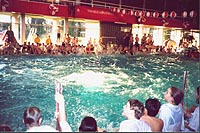
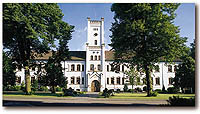
The particularly well-preserved remains of Aurich`s former defence ramparts, the "Hoher Wall".
Indoor swimming baths
The castle, built from 1851 to 1855 on the foundations of a previous castle.
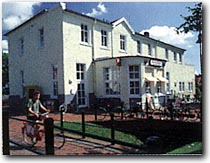
The station building at the central bus station (ZOB) houses the Aurich Transport Office
(tourist information,accomodation, entry tickets, train and boat tickets) and the offices of the local public transport network (ÖPNV).
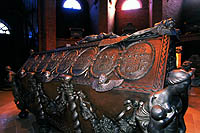

The mausoleum is the final resting place of former East Friesian ruling aristocrats in highly ornate sarcophagi. Well worth a visit.
A scene at Aurichs open-air swimming pool.
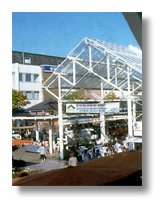
The newly laid-out market place, showing the spherical well and the covered market hall, whose outer walls are veritable works of art, portraying the foods which are on offer indoors. Under the market is the central underground carpark, which makes Aurich so accessible for motorists.
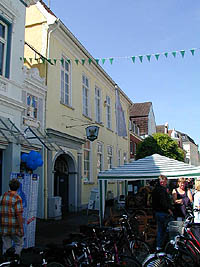
Lambertshof and St. Lamberts church (built 1832-35). Inside is the valuable Ihlow Altar, carved around 1500 by the St Luke`s Guild in Antwerp. The buildings here are the oldest in Aurich: the bell tower and the houses opposite it "Hansteinsche Haus" and the pub "Ewige Lampe". The bell tower is a symbol of Aurich which stands out above its surroundings.
The Museum of Local History in the Old Chancellory, Burgstraße (in the pedestrian precinct).
Opening times: Tues. - Sun. 11.00-17.00hrs. Guided tours for groups are available: Tel.04941 / 1 83 11.
Here you can also visit the Mach-Mit-Museum Miraculum with activities for children.
Opening times: Tues.-Fri. 13.00-17.00hrs and Sat.-Sun. 11.00-17.00hrs.
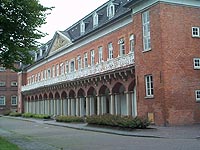
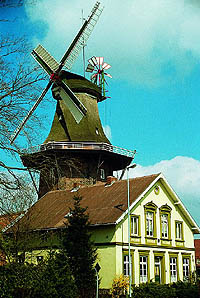
The Marstallgebäude, stables and coachhouse, in the castle square, one of the most attractive buildings in the town. Nowadays it houses offices of the Lower Saxony Regional Government.
The windmill museum "Stiftsmühle", a working museum on five storeys providing a fine view of the town from the gallery.
Opening times: Tues.-Sat. 11.00-17.00hrs, Sun. 15.00-17.00hrs
Guided tours: Tues. and Fri. 15.00hrs.
Groups by arrangement: tel. 04941 / 99 42 90.
A group of seals playing in the pedestrian precinct.
Guided tours of Aurich
Individuals: from May to early October, each Saturday, starting at the tourist information at 10 o`clock.
Guided tour of the Mausoleum
From May to October on the first Thursday of a month. Meeting at the Mausoleum, 17.00hrs.
Arrangements for groups
Guided tours of the town catering for general interest
Specialist tours
Tours for children and for the handicapped
Guided cycle tours (on your own bike) by arrangement
Groups should not exceed 25 persons.
East Friesia is so different
Suggestions for trips to the coast / bus guides are available from our trained and experienced town guides. Tel. 04941 / 1 88 80 or 86 05 Fax: 04941 / 6 47 50 or 8 78 51
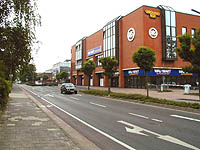
The shopping and leisure centre Carolinenhof with spacious underground parking on two levels.
A scene from one of the bowling alleys on the second floor, where there are cinemas, disco and various restaurants, situated around a village square.
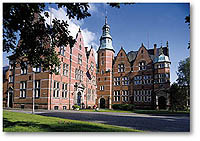
The fine, neo-renaissance building of the Ostfriesische Landschaft , once a regional parliament, which today works to preserve and support Friesian traditions and culture. Its library is next door.
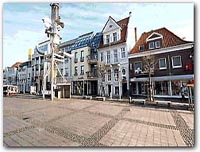
The newly-built market place showing the facade of the bank (Sparkasse) and the Sous-Tower. The picture was taken at the opening of the annual town fair.



